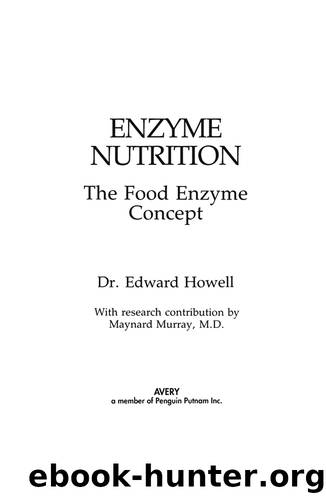Enzyme Nutrition by Edward Howell

Author:Edward Howell [Howell, Edward]
Language: eng
Format: epub
ISBN: 9781101662526
Publisher: Penguin Publishing Group
Published: 1994-12-31T16:00:00+00:00
Sugar and Coronary Disease
In an article in the American Heart Journal (1970), Dr. J. Yudkin, University of London, stressed that facts continue to accumulate which do not support the concept that dietary fat is the major factor in coronary heart disease (disease of the coronary arteries, which supply blood directly to the heart). He explained that there has been a rise in sugar consumption in England and the USA some twenty times in the last two centuries. As in other countries, the rise in sugar consumption parallels the increase in coronary heart disease. Dr. T.L. Cleave in the Lancet (1968) compared the high incidence of diabetes and coronary disease in the Indians living in Natal (a province of South Africa), who consume 110 pounds of sugar each per year, to the low incidence of these diseases in Indians living in India and consuming only 12 pounds of sugar per year. Incidentally, the Natal Indians consume their fats mostly in the unsaturated form. Purified corn oil is a skeletonized unsaturated fat. Butter produced from certified raw milk is a natural saturated fat. From the standpoint of ultimate nutrition there is no choice between sugar and dietary fats. Both sugar and fats are skeletonized, that is, highly refined and providing only empty calories. Neither does any good. The only question can be which does the most harm. It is like a choice between the moon and Mars as a place to spend a delightful vacation, providing no respite from the prospect of danger and death.
The latest explosive evidence incriminating table sugar as the chief architect of heart disease comes from the University of Hawaii (1972). C.C. Brooks and his associates fed pigs high-sugar diets. Sixty-eight out of eighty pigs developed heart disease in the left half of the heart. This backs up the contention of Dr. Yudkin and others have been making for many years. A remarkable added finding was that in pigs in which 10 percent of the sugar was replaced by coconut oil or beef tallow, the heart remained free from the endocarditis that afflicted the animals. This may confound those who have been apprehensive about fat in the diet.
In a report entitled, “How Sweet It Is!” Dr. R. Arky of Harvard Medical School (1972) pointed out that in the pre-insulin era, diabetes was regarded as a defect in carbohydrate metabolism, whereas now it has come to be recognized that it involves not only carbohydrate metabolism, but fat and protein also. Arky emphasized that it is important to maintain a normal body weight, and to change the type of carbohydrate from soft drinks, candies, and pastries, to a more wholesome variety.
Download
This site does not store any files on its server. We only index and link to content provided by other sites. Please contact the content providers to delete copyright contents if any and email us, we'll remove relevant links or contents immediately.
Nutrition for Sport, Exercise, and Health by Spano Marie & Kruskall Laura & Thomas D. Travis(3559)
Nutrition for Sport, Exercise, and Health by Marie Spano & Laura Kruskall & D. Travis Thomas(3553)
The Sprouting Book by Ann Wigmore(3414)
Flavor Flours by Alice Medrich(2648)
Memory Rescue by Daniel G. Amen(2260)
Superfood Smoothie Bowls: Delicious, Satisfying, Protein-Packed Blends that Boost Energy and Burn Fat by Chace Daniella(2238)
Dirty Genes by Ben Lynch(2163)
The Bad Food Bible by Aaron Carroll(2125)
The Poisoner's Handbook by Deborah Blum(1982)
Genius Foods by Max Lugavere(1977)
Good Calories, Bad Calories by Gary Taubes(1954)
The Main Street Vegan Academy Cookbook by Victoria Moran(1942)
The I Quit Sugar Cookbook by Sarah Wilson(1880)
Core Performance Essentials by Mark Verstegen(1862)
Memory Rescue: Supercharge Your Brain, Reverse Memory Loss, and Remember What Matters Most by Amen Dr. Daniel G(1850)
Big Girls Do It Stronger by Jasinda Wilder(1805)
Android App Development by Franceschi Hervé J.;(1735)
Sugar Crush by Dr. Richard Jacoby(1689)
Dr. Colbert's Keto Zone Diet by Don Colbert(1549)
